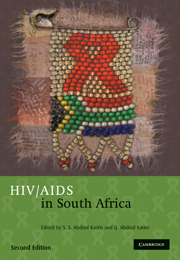Book contents
- Frontmatter
- Contents
- List of Contributors
- Foreword: Peter Piot
- Foreword: Nelson R Mandela
- Acknowledgements
- Section 1 Birth of a rapidly growing epidemic
- Section 2 The virus, the human host and their interactions
- 5 Viral structure, replication, tropism, pathogenesis and natural history
- 6 HIV diagnostics
- 7 HIV-1 genetic diversity
- 8 Cellular immunity in HIV: a synthesis of responses to preserve self
- Section 3 HIV risk factors and prevention strategiess
- Section 4 Focal groups for understanding the HIV epidemic
- Section 5 The impact of AIDS
- Section 6 Treating HIV
- Section 7 What does the future hold?
- Index
5 - Viral structure, replication, tropism, pathogenesis and natural history
Published online by Cambridge University Press: 07 September 2011
- Frontmatter
- Contents
- List of Contributors
- Foreword: Peter Piot
- Foreword: Nelson R Mandela
- Acknowledgements
- Section 1 Birth of a rapidly growing epidemic
- Section 2 The virus, the human host and their interactions
- 5 Viral structure, replication, tropism, pathogenesis and natural history
- 6 HIV diagnostics
- 7 HIV-1 genetic diversity
- 8 Cellular immunity in HIV: a synthesis of responses to preserve self
- Section 3 HIV risk factors and prevention strategiess
- Section 4 Focal groups for understanding the HIV epidemic
- Section 5 The impact of AIDS
- Section 6 Treating HIV
- Section 7 What does the future hold?
- Index
Summary
HIV IS A RETROVIRUS, so named because it encodes the enzyme reverse transcriptase. This unique enzyme allows a DNA copy to be made from viral RNA, going against what is considered the normal flow of genetic information, hence retro ‘to go backwards’. HIV genetic material exists both as genomic RNA inside viral particles and as proviral DNA in the nucleus of infected cells. Both forms are infectious and the latter allows HIV to persist in long-lived reservoirs, thwarting efforts to clear HIV from the body.
The viral enzymes reverse transcriptase and protease, have afforded the best targets for interrupting the viral life cycle. Antiretroviral drugs targeting these two enzymes have proven highly effective in reducing the morbidity and mortality of aids. However, as a result of hiv's ability to mutate, resistance to these drugs has emerged and poses a threat to their continued success. More recently drugs targeting the entry stage of the viral life-cycle have been licensed for human use. Entry inhibitors bind to either the viral envelope glycoprotein or the host receptors, preventing the interaction between the virus and host cell. Because of their mechanism of action these drugs may prove to be particularly useful as preventive agents and many are being considered in microbicide formulations.
An hiv vaccine is considered the best hope for controlling the hiv pandemic. However, developing a vaccine able to stimulate protective immune responses has proven to be extremely difficult.
- Type
- Chapter
- Information
- HIV/AIDS in South Africa , pp. 87 - 96Publisher: Cambridge University PressPrint publication year: 2010



